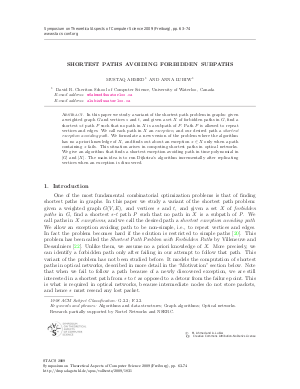Shortest Paths Avoiding Forbidden Subpaths
Authors Mustaq Ahmed, Anna Lubiw
-
Part of:
Volume:
26th International Symposium on Theoretical Aspects of Computer Science (STACS 2009)
Part of: Series: Leibniz International Proceedings in Informatics (LIPIcs)
Part of: Conference: Symposium on Theoretical Aspects of Computer Science (STACS) - License:
 Creative Commons Attribution-NoDerivs 3.0 Unported license
Creative Commons Attribution-NoDerivs 3.0 Unported license
- Publication Date: 2009-02-19
File

PDF
LIPIcs.STACS.2009.1831.pdf
- Filesize: 206 kB
- 12 pages
Document Identifiers
Subject Classification
Keywords
- Algorithms and data structures
- Graph algorithms
- Optical networks
Metrics
- Access Statistics
-
Total Accesses (updated on a weekly basis)
0Document
0Metadata
Abstract
In this paper we study a variant of the shortest path problem in graphs: given a weighted graph $G$ and vertices $s$ and $t$, and given a set $X$ of forbidden paths in $G$, find a shortest $s$-$t$ path $P$ such that no path in $X$ is a subpath of $P$. Path $P$ is allowed to repeat vertices and edges. We call each path in $X$ an \emph{exception}, and our desired path a \emph{shortest exception avoiding path}. We formulate a new version of the problem where the algorithm has no a priori knowledge of $X$, and finds out about an exception $x \in X$ only when a path containing $x$ fails. This situation arises in computing shortest paths in optical networks. We give an algorithm that finds a shortest exception avoiding path in time polynomial in $|G|$ and $|X|$. The main idea is to run Dijkstra's algorithm incrementally after replicating vertices when an exception is discovered.
Cite As Get BibTex
Mustaq Ahmed and Anna Lubiw. Shortest Paths Avoiding Forbidden Subpaths. In 26th International Symposium on Theoretical Aspects of Computer Science. Leibniz International Proceedings in Informatics (LIPIcs), Volume 3, pp. 63-74, Schloss Dagstuhl – Leibniz-Zentrum für Informatik (2009)
https://doi.org/10.4230/LIPIcs.STACS.2009.1831
BibTex
@InProceedings{ahmed_et_al:LIPIcs.STACS.2009.1831,
author = {Ahmed, Mustaq and Lubiw, Anna},
title = {{Shortest Paths Avoiding Forbidden Subpaths}},
booktitle = {26th International Symposium on Theoretical Aspects of Computer Science},
pages = {63--74},
series = {Leibniz International Proceedings in Informatics (LIPIcs)},
ISBN = {978-3-939897-09-5},
ISSN = {1868-8969},
year = {2009},
volume = {3},
editor = {Albers, Susanne and Marion, Jean-Yves},
publisher = {Schloss Dagstuhl -- Leibniz-Zentrum f{\"u}r Informatik},
address = {Dagstuhl, Germany},
URL = {https://drops.dagstuhl.de/entities/document/10.4230/LIPIcs.STACS.2009.1831},
URN = {urn:nbn:de:0030-drops-18318},
doi = {10.4230/LIPIcs.STACS.2009.1831},
annote = {Keywords: Algorithms and data structures, Graph algorithms, Optical networks}
}
